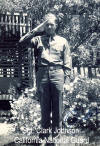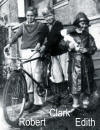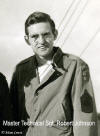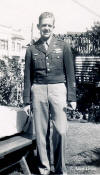In a departure from the rest of this site, this page is devoted to a gallant company commander. The family photos, courtesy of his namesake nephew Clark Johnson, are thumbnails. Click on one to see it full size.

 Clark
Edward Johnson, a son of Swedish immigrants, was born on
January 17, 1919 in Marquette Michigan. The family included his
parents, big brother Bob and little sister Edie. Eventually they
moved to Oakland where the youngsters grew up in the pre-war years.
In 1935 at the age of only 16 Clark join the 159th Infantry of the
California National Guard. By 1942 he had risen to the rank of
staff sergeant.
Clark
Edward Johnson, a son of Swedish immigrants, was born on
January 17, 1919 in Marquette Michigan. The family included his
parents, big brother Bob and little sister Edie. Eventually they
moved to Oakland where the youngsters grew up in the pre-war years.
In 1935 at the age of only 16 Clark join the 159th Infantry of the
California National Guard. By 1942 he had risen to the rank of
staff sergeant.
 In
September 1942 Sgt. Johnson was accepted into the Army's Officer
Candidate School (OCS) at Ft. Benning, Georgia. In December of
that year he graduated and received his commission as a 2nd Lt., one
of the "90 day wonders". Next he was assigned to the 338th
Infantry and sent to Camp Shelby Mississippi for further training and
integration into a combat unit. After a few months with the
338th 2nd Lt. Johnson was reassigned to the 1st Infantry Division and
sent to North Africa as a platoon leader.
In
September 1942 Sgt. Johnson was accepted into the Army's Officer
Candidate School (OCS) at Ft. Benning, Georgia. In December of
that year he graduated and received his commission as a 2nd Lt., one
of the "90 day wonders". Next he was assigned to the 338th
Infantry and sent to Camp Shelby Mississippi for further training and
integration into a combat unit. After a few months with the
338th 2nd Lt. Johnson was reassigned to the 1st Infantry Division and
sent to North Africa as a platoon leader.
2nd
Lt. Clark
Johnson arrived in North Africa in the spring of 1943 as a member of the famed First Infantry Division, the Big Red One. He served continuously in its 18th
Infantry Regiment until the war was over in May 1945. According to the book Danger Forward the Story of the First Division in World War II, a total of 43,743 served in the division during the war. The division's combat started in Nov 1942 with the invasion of North Africa and continued until the final surrender on VE-Day May 8, 1945.
This is Lt. Johnson's shoulder patch.
in the spring of 1943 as a member of the famed First Infantry Division, the Big Red One. He served continuously in its 18th
Infantry Regiment until the war was over in May 1945. According to the book Danger Forward the Story of the First Division in World War II, a total of 43,743 served in the division during the war. The division's combat started in Nov 1942 with the invasion of North Africa and continued until the final surrender on VE-Day May 8, 1945.
This is Lt. Johnson's shoulder patch.
Clark Johnson's combat assignments were:
-
Platoon Leader, Headquarters 1st Division, effective 29 Mar 1943
-
Platoon Leader, Antitank Company, 18th Infantry, effective 21Jun 1943
-
Executive Officer Company K, 18th Infantry effective 10 Feb 1945
-
Company Commander, Company K, 18th Infantry effective 28 Feb 1945 and
going until the end of hostilities.
He was promoted to 1st Lieutenant on July 1, 1944 and to Captain on May 8, 1945.
The appendix in Danger Forward says the 43,743 men were awarded commendations in this number:
Congressional Medal of Honor............ 16
Distinguished Service Cross............. 161
Silver Star............................... 6,116
Soldier's Medal............................ 162
Bronze Star.............................14,138
Lt. Johnson was awarded the Distinguished Service Cross, two Silver Stars, the Soldier's Medal, and two Bronze Stars.
Many years after the war an interview with him was published in his local Grant's Pass, Oregon newspaper which says in part "Under his command, Johnson's company was one of the most decorated during World War II ... with five of his men receiving Congressional Medals."
![]()
 Lt. Johnson's complete awards and decorations
including his combat service in Korea can be seen by clicking on this photo. His European Theatre campaign medal
for WW2 action shows a silver star for his participation in five officially recognized battles....Tunisia, Northern France, Rhineland, Ardennes-Alsace, and Central Europe, and two arrowheads for being in the initial beach landings at Sicily and Normandy.
Lt. Johnson's complete awards and decorations
including his combat service in Korea can be seen by clicking on this photo. His European Theatre campaign medal
for WW2 action shows a silver star for his participation in five officially recognized battles....Tunisia, Northern France, Rhineland, Ardennes-Alsace, and Central Europe, and two arrowheads for being in the initial beach landings at Sicily and Normandy.
Here, in the order awarded, are the citations for his awards.
The Soldier's Medal. Awarded to Lt. Johnson in September 1943, the Soldier's Medal is for heroism not involving actual combat with an armed enemy. Judging by the date
of the citation it must be for saving the drowning soldier during the invasion of Sicily
on July 10, 1943. One of the arrowheads on his campaign medal is documented in his service record for being in the first day's landing in Sicily. The citation for the Soldier's Medal reads:
"CLARK E. JOHNSON, 01302005, SECOND LIEUTENANT, Infantry. For heroism. During landing operations, Lieutenant Johnson, without thought of his own safety, rescued an enlisted man who had lost consciousness and was on the verge of drowning in a heavy surf. His skillful applications of artificial respiration undoubtedly saved this soldier's life. Residence at appointment: Oakland, Calif." (Ref. GO 47, HQ 1st US Inf Div, 17 Sept 1943.)
During landing operations, Lieutenant Johnson, without thought of his own safety, rescued an enlisted man who had lost consciousness and was on the verge of drowning in a heavy surf. His skillful applications of artificial respiration undoubtedly saved this soldier's life. Residence at appointment: Oakland, Calif." (Ref. GO 47, HQ 1st US Inf Div, 17 Sept 1943.)
The first Bronze Star. The Bronze Star is awarded to individuals who serve in combat and distinguish themselves with either heroism, outstanding achievement or meritorious service. Lt Johnson's award is for meritorious achievement during the 1st Division's combat in Sicily. The Bronze Star wasn't authorized until February 1944 so in this case it was awarded somewhat later than the action. Note that Sicily is considered to be in the North African Theater. The citation for the
first Bronze Star is:
"CLARK E. JOHNSON, 01302005, FIRST LIEUTENANT, Antitank Company, 18th Infantry. For meritorious achievement in connection with military operations against the enemy in the North African Theater of Operations from 10 July 1943 to 17 Aug 1943. Residence at appointment: Oakland, California." (Ref. GO 21, HQ 1st US Inf Div, 23 Jan 1945.)
Infantry. For meritorious achievement in connection with military operations against the enemy in the North African Theater of Operations from 10 July 1943 to 17 Aug 1943. Residence at appointment: Oakland, California." (Ref. GO 21, HQ 1st US Inf Div, 23 Jan 1945.)
The first Silver Star. The 1st Infantry Division spearheaded the D-Day invasion of Omaha Beach. Coleville-sur-Mer is about a mile from the beach and the closest town. Lt. Johnson was in the
initial invasion force on June 6 as denoted by the second arrowhead on his
European Theatre campaign medal. The citation for Lt. Johnson's Silver Star says:
"CLARK E. JOHNSON, 01302005, FIRST LIEUTENANT (then SECOND LIEUTENANT), Antitank Company, 18th Infantry. For gallantry in action in the vicinity of Colleville-sur-Mer, Normandy, France, 6 June 1944. Voluntarily crossing hazardous terrain, despite intense enemy machine gun fire, Lieutenant Johnson, at great personal risk, eliminated a number of hostile snipers, thereby facilitating his company's advance inland. Lieutenant Johnson's gallantry and unselfish devotion to duty contributed materially to the success of the invasion. Residence at appointment: Oakland, California." (Ref. GO 98, HQ 1st US Inf Div, 5 Oct 1944.)
vicinity of Colleville-sur-Mer, Normandy, France, 6 June 1944. Voluntarily crossing hazardous terrain, despite intense enemy machine gun fire, Lieutenant Johnson, at great personal risk, eliminated a number of hostile snipers, thereby facilitating his company's advance inland. Lieutenant Johnson's gallantry and unselfish devotion to duty contributed materially to the success of the invasion. Residence at appointment: Oakland, California." (Ref. GO 98, HQ 1st US Inf Div, 5 Oct 1944.)
The second Silver Star. After Gen. Patton's breakout from Normandy and the collapse of the Falaise pocket the race was on across France. The remaining German forces were trying to get back to eastern France and Germany to establish a viable defensive position. The Allies were going full speed ahead to cut them off. There were very few front lines and troops from both sides often found themselves next to, behind, or in front of the enemy. The citation for Lt Johnson's second Silver Star reads:
"CLARK E. JOHNSON, 01302005, FIRST LIEUTENANT, Antitank Company, 18th Infantry.  For gallantry in action in the vicinity of Esqueheries, Ile-de-France, France, 2 September 1944. While leading a motorized reconnaissance patrol through enemy territory, Lieutenant Johnson learned that another friendly group was trapped in the area and was in danger of being annihilated. Leaving one of his men in a strategic position to provide covering fire, he maneuvered a vehicle to a vantage point near the besieged group and, with effective machine-gun fire, enabled the men to reorganize and destroy their assailants. Lieutenant Johnson's aggressiveness and gallantry were directly responsible for preventing heavy loss of life. Residence at appointment: Oakland, California." (Ref. GO 34, HQ 1st US Inf Div, 8 Feb 1945.)
For gallantry in action in the vicinity of Esqueheries, Ile-de-France, France, 2 September 1944. While leading a motorized reconnaissance patrol through enemy territory, Lieutenant Johnson learned that another friendly group was trapped in the area and was in danger of being annihilated. Leaving one of his men in a strategic position to provide covering fire, he maneuvered a vehicle to a vantage point near the besieged group and, with effective machine-gun fire, enabled the men to reorganize and destroy their assailants. Lieutenant Johnson's aggressiveness and gallantry were directly responsible for preventing heavy loss of life. Residence at appointment: Oakland, California." (Ref. GO 34, HQ 1st US Inf Div, 8 Feb 1945.)
The Distinguished Service Cross (DSC).
The DSC is the second highest award for heroism, ranking just below
the Medal of Honor. On MArch 9, 1945, Combat Command B of the Ninth Armored Division captured the Hindenberg Bridge at Remagen. The Rhine River had been crossed thus breaching the last great natural barrier to Germany's interior. The 1st Division was only 10 miles from Remagen and was ordered to change direction and cross the river. The German Army organized a defense with the goal of containing or eliminating the Allied units on the eastern side of the river
and sent remnants of several panzer divisions and the 5th Panzer Army to the area. According to the account in Danger Forward the height of German resistance was on March 24-25 when fourteen
separate German counterattacks were repelled. The 1st Division was in the thick of it and fought against 3 Panzer divisions.
With the bridgehead now secure the division was sent North to help with the encirclement of the Ruhr valley. On March 30 elements of the Division went on the attack again. The citation for Lt Johnson's Distinguished Service Cross is:
"First Lieutenant CLARK E. JOHNSON, 013002005, Infantry,  Company K, 18th Infantry Regiment, 1st Infantry Division, United States Army. For extraordinary heroism in connection with military operations against an armed enemy in GERMANY. During action near EISERN, GERMANY, on 30 March 1945, Lieutenant JOHNSON organized his isolated company and crawling through a hail of enemy fire, personally placed their five attached tanks in advantageous positions. He signaled the attack and firing his carbine as he ran, charged the enemy flank and prevented a link up between the main garrison and a body of reinforcements. He continued forward and fearlessly led a platoon in a surprise attack on the German command post, killing many of the defenders and capturing the commanding officer and his staff. Lieutenant JOHNSON'S heroic inspiring leadership exemplifies the highest traditions of the military service." (Ref. GO 123, HQ Third US Army, 31 May 1945.) During this same action 2 Medals of Honor were awarded posthumously to men of Company K.... Staff Sergeant George Peterson and 1st Lt. Walter Will. Click here for their citations 18th Inf, Co K MoH.
Company K, 18th Infantry Regiment, 1st Infantry Division, United States Army. For extraordinary heroism in connection with military operations against an armed enemy in GERMANY. During action near EISERN, GERMANY, on 30 March 1945, Lieutenant JOHNSON organized his isolated company and crawling through a hail of enemy fire, personally placed their five attached tanks in advantageous positions. He signaled the attack and firing his carbine as he ran, charged the enemy flank and prevented a link up between the main garrison and a body of reinforcements. He continued forward and fearlessly led a platoon in a surprise attack on the German command post, killing many of the defenders and capturing the commanding officer and his staff. Lieutenant JOHNSON'S heroic inspiring leadership exemplifies the highest traditions of the military service." (Ref. GO 123, HQ Third US Army, 31 May 1945.) During this same action 2 Medals of Honor were awarded posthumously to men of Company K.... Staff Sergeant George Peterson and 1st Lt. Walter Will. Click here for their citations 18th Inf, Co K MoH.
The
second Bronze Star.
![]() Those whose saw active ground combat in the Army and performed
satisfactorily were awarded the Combat Infantryman Badge (CIB).
In September 1947 a Bronze Star was authorized for anyone who received
the CIB. These 2 are recorded in Lt. Johnson's service record as
"CIB AR 600-70" and "Bronze Star 1st Inf Div". Shown at right is
Lt. Johnson's CIB. The star at the top signifies an additional
award of the CIB for combat in Korea.
Those whose saw active ground combat in the Army and performed
satisfactorily were awarded the Combat Infantryman Badge (CIB).
In September 1947 a Bronze Star was authorized for anyone who received
the CIB. These 2 are recorded in Lt. Johnson's service record as
"CIB AR 600-70" and "Bronze Star 1st Inf Div". Shown at right is
Lt. Johnson's CIB. The star at the top signifies an additional
award of the CIB for combat in Korea.


 Capt.
Johnson returned home in late 1945. In these snapshots of him
from that time period you can see the CIB, 5 overseas stripes on the
sleeve (6 months for each) and ribbons for the valor awards. And
it was time to catch up with the family, especially brother Bob who
served in the 11th Air Force's Weather Service on Attu, Aleutian
Islands, Alaska.
Capt.
Johnson returned home in late 1945. In these snapshots of him
from that time period you can see the CIB, 5 overseas stripes on the
sleeve (6 months for each) and ribbons for the valor awards. And
it was time to catch up with the family, especially brother Bob who
served in the 11th Air Force's Weather Service on Attu, Aleutian
Islands, Alaska.
Capt. Johnson stayed in the Army Reserves from December 1945 until October 1948 when he reentered active duty. When the Korean War started has was sent from Fort Ord to Korea to be a company commander in the 17th Infantry already stationed there. The Chinese Communist offensive was launched in late 1950 and Capt. Johnson was one of the many who suffered frostbite in that severe winter. He returned to the states in 1951 and spent several years in the 11th Infantry, mostly at Fort Ord, California. He retired a Lt. Col. with 28 years of service in 1964.
Clark Edward Johnson passed away in Grants Pass, Oregon on January 29, 1995. A WW2 hero was taken from us. May he rest in peace.
Note: I am indebted to Brandon Wiegand for tracking down the citations for the 2 Silver Stars and Distinguished Service Cross. Brandon is a military researcher and can be reached at saw10thpainf@hotmail.com Please visit his website at http://ddaymilitaria.com/ It was a pleasure to work with Brandon and I recommend him to all.